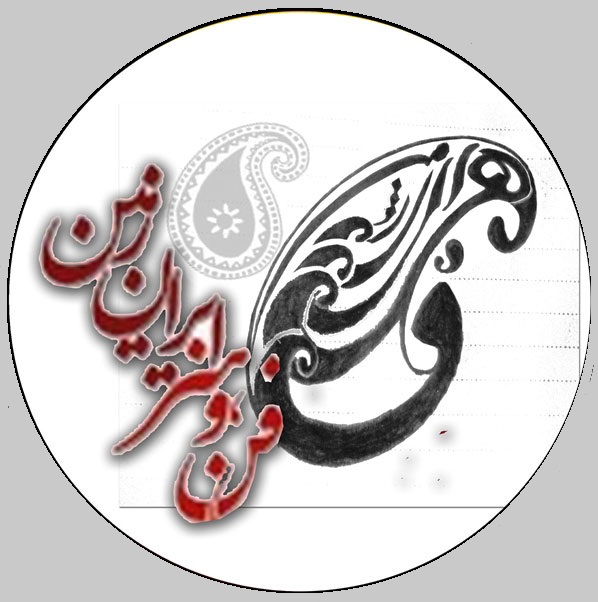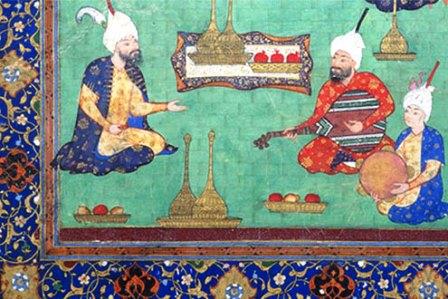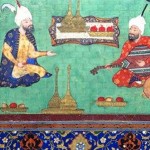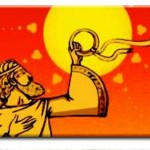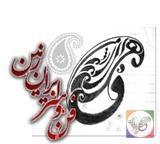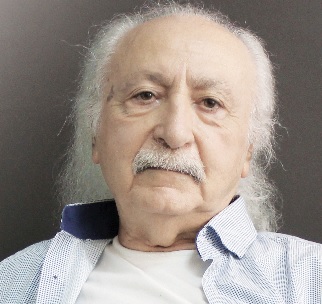Festivals
- Norooz – New Year Festival
- جشن ایرانیان Iranians celebrate جشن آبپاشان celebrate sprinklers
- جشن ایرانیان Iranians celebrate جشن آبپاشان celebrate sprinklers
Iranians created many feasts and celebrations to pay homage to many deities and they are mostly farming festivals.
Iranians divide the Iranian year into two equal parts or seasons. The first season was summer or ‘Hama’ and the second was winter or ‘Zayana’. The coming of the two seasons would be celebrated through Norooz and Mehregan. The later is the festival dedicated to Mehr Izad. It is celebrated on the 16th of the seventh month (Mehr) at the time of the harvest festivals and beginning of the winter. It has been the second most elaborate celebration after Norooz.
Mehr has been Mithra in Avesta and Mitrah in Phahlavi. It‘ Payman e Dousti’ (contract of friendship). In modern Persian it means love and kindness.
Norooz – New Year Festival
Norooz is the traditional Iranian festival of spring which starts at the exact moment of the vernal equinox, commencing the start of the spring (March 20/21). Today the festival of Norooz is celebrated in Iran, Iraq, India, Afghanistan, Turkey, Tajikestan, Uzbekistan, Azerbaijan, Kazakhstan, and Kyrgyzstan and many other countries in the region. Norooz is the Persians’ longest and most cherished festivity, on which all Iranians celebrate the New Year with the nature’s resurrection from withered winter. The celebration start a few weeks before the New Year, Iranian housekeepers set out to do the spring-cleaning, “Khaane-Tekaani” in Persian and remove old and not used items. They make/buy new clothes and shoes for member of family and they wear it on first day of New Year, bake pastries and germinate seeds as sign of renewal of nature. Troubadours, referred to as Haji Firuz, disguise themselves with makeup and wear brightly colored outfits of satin. These Haji Firuz, singing and dancing, parade as a carnival through the streets with tambourines, kettle drums, and trumpets to spread good cheer and the news of the coming new year.
The vendors selling New Year items like fresh herbs and colored eggs and live fish. The town and bazaar atmosphere and feeling will change weeks before New Year.
Norooz has its own particular dishes, too. “Sabzi-Polo Mahi”, rice with green herbs and fish, is served on the night just preceding Norooz, or on the same Norooz day.
The young call on the elder first to demonstrate the respect that Iranians pay to the aged people. Older give “Eidi”, new-year gift to younger and this is another characteristic feature of Norooz.
The origin of Norooz goes back several thousand years predating the Achaemenian Dynasty.
Today, the tradition is continued through the setting of a special table or spread with an arrangement of specific symbolic items, seven of which have names that start with the Persian letter Seen (s).
These are:
Sabzeh – Wheat or lentils grown in a tray or dish prior to Norooz to represent rebirth.
Samanu – A sweet pudding made from wheat germ, symbolizing affluence.
Senjed – The dried fruit of the lotus tree which represents love.
Seer – Meaning garlic in Persian, and represents medicine.
Seeb – Meaning apple in Persian, and represents beauty and health.
Somaq – Sumac berries, which represent the color of the sun rise.
Serkeh – Meaning vinegar in Persian, and represents age and patience.
Sonbol – The hyacinth flower with its strong fragrance heralding the coming of spring.
Sekkeh – Coins representing prosperity and wealth.
Read more about Norooz
Read more about Norooz
Read more about Norooz
Chahrshanbe Souri – Festival of fire
“Give me your fiery red color/ take back my wintry shallowness yellow.” It is an annual ritual which is held on the eve of the last Wednesday of the Iranian year.
Chahrshanbe Souri is the symbol of good health, cultivation, light, and purity to the Iranian. It is believed that the ritual guarantees the dissipation of the misfortunes and evils, and of course, the materialization of people’s hopes and desires for the next year.
Before the dusk, seven, as a symbol for the seven Zoroastrian angels (Amshaaspandan), heaps of bushes (of weed) are gathered before the house-gate or on the roof of the house -some visible place for the “ghosts” to guide. After the night has fallen on, the heaps are kindled and the uproarious tumult begins.
It is time for everybody to leap over the bonfires. They dance and sing merry notes. The traditional song of the night is: “Sorkhi-e man az to/ Zardi-e to az man”, literally it means “Give me your fiery red color and take back my wintry shallowness”.
Qaashoq-Zani (Spoon-hitting)
Very much like Halloween and in full disguise, usually a veil (chador) covering the entire body, longing youths go to seven different houses and make a noise by hitting a bowl with a spoon to signal the household residing in the house. Being presented, by the household, with some treat betokens a positive omen, and vice versa.
Faal-e-Gusheneshini (solitary telling of the fortune) Young women longing for a spouse make a wish, then having hidden themselves in some invisible dark corner of a passage, listen to the passers-by’s talks, according to which they decide whether their wish will or will not be fulfilled; passers-by’s positive talk signifies good omens, and unpleasant words point to some ill portent.
Kuze-Shekani (earthenware jar-shattering)
The household put some coal, as the sign of ill omen, and some salt, standing for evil eye, plus a cheap coin, signifying poverty, inside an earthenware jar. They turn the earthenware jar around their heads one by one. Then, one of them throws the jar over the roof onto the alley. Thus, ill omen, evil eye and poverty are driven out of the house.
Gereh-Goshaee
Similarly, women yearning to tie the knot or persons who have run into some problem, make a knot at the corner of a handkerchief or some other garment and request the first person whom they come across to undo it. The person’s willingness will signal a hopeful portent.
Shaal-Andazi (shawl-dropping)
In some parts of the country, young boys, who are engaged, drop a shawl or wraparound down from the roof of their fiancée’s house and she would present him with some confection or other present. Along with these rites, there are also others such as making soup for the sick, discarding the outworn furniture, etc. In some areas, the young get their horses out and make a performance on it before the night falls on.
Sizdeh Bedar
Millions of Iranians spend outdoors on the final day of celebrations for the New Year holidays. The term sizdeh bedar literally means “out with the thirteenth”. To Iranians, the number “13” symbolizes evil and bad luck.
The annual “Sizdeh Bedar” picnic is based on an ancient Iranian tradition that encourages people to avoid any ill omens at home by going outdoors on the 13th day of the new year. This day inaugurates a happy New Year.
In Iranian tradition, the first 12 days of the new year symbolize order in the world and in people’s lives. The 13th day marks the return to ordinary daily life.
In one of the traditions, young ladies tie together blades of grass in hope of finding their ideal husbands. The gesture represents the bond between a man and a woman. Girls weave together fresh herbs, singing as they do so in a low voice: Sizdeh bedar, sal-e degar, khaneye shohar, bacheh be baqal (sizdeh bedar, next year, at the husband’s house, a baby in my arms).
Mehregan – Fall Festival
This feast would be celebrated for 6 days, starting on the 16th ‘ of Month Mehr The oldest historical record about Mehregan goes back to the Achaemenian times. The Historian, Strabon (66 – 24 BC) has mentioned that the Armenian Satrap (governor) presented the Achaemenian king with 20,000 horses at the Mehregan celebrations.
The festival prayers are performed by the Mobads (priests) and gifts such as pure oil for the sanctuary lamps, candles and incense are presented to the local shrines. Esphand a local popular incense is burnt and sweet smelling flowers and herbs are dedicated to the temples. Contrary to the ancient times, there is no rigidly prescribed pattern of behavior for approaching the shrines, but many still touch the doorsill before entering in a graceful gesture of obeisance, while uttering prayers and invocations. Iranian Muslims still follow the same procedure once approaching a mosque.
For the ancient Iranians Mehr symbolized truthfulness, bravery and courage. These attributes were re-enforced and venerated through prayers, rituals, feasts, celebrations and acts of charity. Though most modern Iranians have heard about Mehregan, but unlike Norooz it is not celebrated by all and is mainly regarded as a Zoroastrian festival. In the recent years there has been a revival of this joyful and merry occasion both in Iran and outside and more Iranians are participating in this festival. Also since, school year starts on 1st of the Persian month Mehr, on about 23 September, in Iran, Mehregan is celebrated as a time to rejoice learning and knowledge to make the festival more acceptable with the Islamic authorities.
Sadeh – Mid–Winter Festival
Sadeh meaning hundred, is a mid winter festival in Iran. It is a festivity to honor fire and to defeat the forces of darkness, frost and cold. It is celebration marked the hundred day and nights (50 days and 50 nights) before the Norooz and the hundredth day after the summer. This day coincides with 10th of Bahman in present calendar.
The ceremony starts with huge bon fires. People would dance around the fires. The most elaborate report of the celebration comes from the 10th century during the reign of Mardavij Zeyari, the ruler of Isfahan. From Iranian origin the Zeyari family did their best to keep the old traditions alive. Huge bon fires were set up on both sides of the ‘Zayandeh Rood’, the main river dividing the city. The fires were contained in specially build metal holders to maintain control. Hundreds of birds were released while carrying little fireballs to light the sky. There were fireworks, clowns, dance and music with lavish feasts of roasted lamb, beef, chicken and other delicacies.
The wood gathered would be taken to the local shrine and on their return home if it is their first time there will be a celebration for the boys at home with friends and relatives. However this practice is becoming more difficult these days and attempts are made to preserve it. The work is hard, wood more scarce than ever, fewer boys are prepared to attempt it and safety is a major concern. In addition massive emigration into the cities or outside the country has significantly reduced the number of boys available for this occasion.
The fire is kept burning all night. The day after, first thing in the morning, women would go to the fire and each one will carry a small portion back to their homes and new glowing fires are made from the ritually blessed fire. This is to spread the blessing of the Sadeh fire to every household in the neighborhood. Whatever that is left of the fire will be taken back to the shrine to be pilled in one container and will be kept at the temple. The festivities would normally go on for three days and the wood gathering by the boys door to door and blessing of the dead happens every night and evenings are spend eating and giving away ‘khairat’ (giving away as a good deed). Food prepared from slaughtered lamb and ‘ash e khairat’ are distributed amongst the less fortunate.
Today, Sadeh is mainly celebrated on 10th of Bahman. The fires may or may not be lit outside and most activities take place inside the shrines. The wood gathering activities are reduced though there are efforts to preserve them. However the bulk of the Iranians are becoming more familiar with the occasion and there are gatherings and celebrations outside Iran. Fires are lit, music, dancing and merriment of all kinds will go on for the rest of the evening. The occasion for the majority of Iranians has no religious significance and no specific rituals are involved other than torching bon fires at sunset and having a merry time and therefore keeping up with the ancient traditions when merriment was venerated and practiced.
Tirgan – The Rain Festival
The festival of Tirgan is observed on July 1st, and it is primarily a rain festival and it is one of the three most widely celebrated feasts (along with Mehregan and Norooz) amongst Iranian peoples. Tir in modern Persian,; Tishtar in Middle Persian or Pahlavi; and Avestan Tishtrya, is the Yazad presiding over the Star Sirius, brightest star in the sky, and of rain, and thus Tir Yazad especially invoked to enhance harvest and counter drought (Av. Apousha).
There appear to have been many customs associated with Tirgan. Mary Boyce (Persian Stronghold of Zoroastrianism) mentions a game of Moradula (‘bead-pot’) or chokâdula (‘fate-pot’). She also related the custom of tying rainbow-colored bands on their wrists which were worn for ten days and then thrown into a stream. She observed during her time in Sharif-Âbâd that many of the charming old Tirgan customs had died away by the 1960’s leaving “merry-making by young people and children, who with a happy license… splash and duck one another in the village streams.”
Tirgan is also associated with the legend of the arrow (‘tir’), which is briefly alluded to in the Tishtar Yasht (Yt8.6): “We honor the bright, khwarrah-endowed star Tishtrya who flies as swiftly to the Vouru-kasha sea as the supernatural arrow which the archer Erexsha, the best archer of the Iranians, shot from Mount Airyo-xshutha to Mount Xwanwant. (7) For Ahura Mazda gave him assistance; so did the waters …”
An expanded account is found in Mirkond, History of the Early Kings of Persia, Erekhsha Khshviwi-ishush (Pahlavi Arash-i Shiwâtir, i.e. ‘Arash of the swift arrow, and in modern Persian, known as Arash-e Kamângir) was the best archer in the Iranian army. When Manouchehr and Afrasiyab determined to make peace and to fix the boundary between Iran and Turan, ‘it was stipulated that Arash should ascend Mount Damâvand, and from thence discharge an arrow towards the east; and that the place in which the arrow fell should form the boundary between the two kingdoms. Arash thereupon ascended the mountain, and discharged towards the east an arrow, the flight of which continued from the dawn of day until noon, when it fell on the banks of the Jeyhun (the Oxus).’
The following Tirgan story tie together many of these elements: It is related that when the wicked Afrasiyab, the Tur, ruled over the country of Iran, it did not rain, at that time, for 8 years. Afrasiyab, the Tur, asked the wise and the astrologers why it was not raining. Zu Tahmasp answered: “You turned faithless, because Freydoun had allotted to you Turkestan (only) and entrusted it to you whereas he had allotted Iran to us and given it to us. You turned away from that covenant and set it aside. It is for this reason that, owing to this sin of yours, it does not rain.” Afrasiyab asked how this could be ascertained. Zu Tahmurasp said: “I shall throw an arrow from here, and where my arrow falls, there will be the boundaries (of your territory).” Afrasiyab accepted it and entered into a compact thus: “I shall consent to have as the boundaries (of my territory) that place where your arrow settles and I shall go out of Iran.” When this compact was entered into, it was on the day Tir of the month Tir that Zu Tahmasp uttered the name of God and threw the arrow from the country of Iran and that arrow fell in the country of Turan by the command of Lord Ohrmazd. When that arrow settled in the country of Turan, Afrasiyab took this witness that the rains did not come on account of his faithlessness. Then Afrasiyab arose from that place and went out of Iran with his army and settled in the country of Turan. The intelligence of this spread on the day Govad and heavy rains poured down on the day Govad. Then they assented to institute a festival in the country of Iran on the day Tir of the month Tir and up to now the Dasturs of Iran write a Nirang (formula) and tie it on the hands of the faithful and remove it from their hands on the day Govad, throw it into the sea on that day for the reason that the glad tidings of the return of Afrasiyab to Turan had reached on the day Govad. It is for this reason that this nirang is untied from the hands and thrown into the sea so that all calamities may sink into the sea.
Yalda Festival or Shab e Cheleh – The Night of the Fortieth
Yalda, a Syriac word imported into the Persian language by the Syriac Christians means birth (tavalud and melaad are from the same origin). It is a relatively recent arrival and it was very likely refereed to the birth of Jesus Christ (Melaad e Massih) in the past. It is used interchangeably with ‘Shab e Cheleh’, a Zoroastrian celebration of Winter Solstice around December 21st. Forty days before the next Persian festival ‘Jashn e Sadeh’: this night has been celebrated in countless cultures for thousands of years. The ancient Roman festivals of Saturnalia (God of Agriculture, Saturn) and Sol Invicta (Sun God) are amongst the best known in the Western world.
In most ancient cultures, including Persia, the start of the solar year has been marked to celebrate the victory of light over darkness and the renewal of the Sun. For instance, Egyptians, four thousand years ago celebrated the rebirth of the sun at this time of the year. They set the length of the festival at 12 days, to reflect the 12 divisions in their sun calendar. They decorated with greenery, using palms with 12 shoots as a symbol of the completed year, since a palm was thought to put forth a shoot each month.
The Persians adopted their annual renewal festival from the Babylonians and incorporated it into the rituals of their own Zoroastrian religion. The last day of the Persian month Azar is the longest night of the year, when the forces of Ahriman are assumed to be at the peak of their strength. While the next day, the first day of the month ‘Day’ known as ‘khoram rooz’ or ‘khore rooz’ (the day of sun) belongs to Ahura Mazda, the Lord of Wisdom. Since the days are getting longer and the nights shorter, this day marks the victory of Sun over the darkness. The occasion was celebrated in the festival of ‘Daygan’ dedicated to Ahura Mazda, on the first day of the month ‘Day’.
Fires would be burnt all night to ensure the defeat of the forces of Ahriman. There were feasts, acts of charity and a number of deities were honored and prayers performed to ensure the total victory of sun that was essential for the protection of winter crops. There would be prayers to Mithra (Mehr) and feasts in his honor, since Mithra is the Eyzad responsible for protecting ‘the light of the early morning’, known as ‘Havangah’. It was also assumed that Ahura Mazda would grant people’s wishes, specially those with no offspring had the hope to be blessed with children if performed all rites on this occasion.
One of the themes of the festival was the temporary subversion of order. Masters and servants reversed roles. The king dressed in white would change place with ordinary people. A mock king was crowned and masquerades spilled into the streets. As the old year died, rules of ordinary living were relaxed. This tradition persisted till Sassanian period, and is mentioned by Biruni and others in their recordings of pre-Islamic rituals and festivals. Its’ origin goes back to the Babylonian New Year celebration.
These people believed the first creation was order that came out of chaos. To appreciate and celebrate the first creation they had a festival and all roles were reversed. Disorder and chaos ruled for a while and eventually order was restored and succeeded at the end of the festival.
The Egyptian and Persian traditions merged in ancient Rome, in a festival to the ancient god of seedtime, Saturn. The Romans exchanged gifts, partied and decorated their homes with greenery. Following the Persian tradition, the usual order of the year was suspended. Grudges and quarrels were forgotten, wars were interrupted or postponed. Businesses, courts and schools were closed. Rich and poor became equal, masters served slaves, and children headed the family. Cross-dressing and masquerades, merriment of all kinds prevailed. A mock king, the Lord of Misrule, was crowned. Candles and lamps chased away the spirits of darkness.
Another related Roman festival celebrated at the same time was dedicated to Sol Invictus (“the invincible sun”). Originally a Syrian deity, the Roman Emperor Heliogabalus imported the cult in to Rome and Sol was made god of the state. With the spread of Christianity, Christmas celebration became the most important Christian festival. In the third century Christians celebrated various dates, from December to April for Christmas. January 6 was the most favored day because it was thought to be Jesus’ Baptismal day (in the Greek Orthodox Church this continues to be the day to celebrate Christmas). In year 350, December 25 was adopted in Rome and gradually almost the entire Christian Church agreed to that date, which coincided, with Winter Solstice and the festivals, Sol Invicta and Saturnalia. Many of the rituals and traditions of the pagan festivals were incorporated into the Christmas celebration and are still observed today.
It is not clear when and how the world ‘Yalda’ entered the Persian language. Iran had a large Christian population. Territories like Armenia that was part of the Persian Empire for centuries were entirely Christian along with other border countries and parts of Byzantine City States continuously changing hands between Persia and Anatolia. The massive persecution of the early Christians in Rome and the later sectarian wars between different Christian sects during the Byzantium era brought many Christian refugees into the Sassanid Empire and it is very likely that these Christians introduced and popularized ‘Yalda’ in Iran. Yalda was their celebration of Christmas. Gradually ‘Shab e Yalda’ and ‘Shab e Cheleh’ became synonymous and the two are used interchangeably.
With the conquest of Islam the religious significance of both Christmas and the ancient Persian festival was lost. Today ‘Shab e Cheleh’ is merely a social occasion, when family and friends get together for fun and merriment. Different kinds of dried fruits, nuts, seeds and fresh winter fruits are consumed. The presence of dried and fresh fruits is reminiscence of the ancient feasts to celebrate and pray to the deities to ensure the protection of the winter crops. Medieval poetry from Hafez is read and fortunes are sought through the interpretation of his poems. This extremely popular poet lived in the 14th century, his poetry is found in almost every household. It is a tradition to make a wish, then open a page randomly and start reading the first poem on that page.
Interpretations of the poem are used to decide whether the wish will come true or not. Before the coming of TV and other mass media it was customary for the grandparents to tell popular old stories to their grandchildren on this night.
Family members gathered around and under a uniquely designed short wooden table covered with large quilts and blankets. A small charcoal fire was prepared in a fire resistant open container with ashes on top to regulate and control the burning charcoal. This was placed under the table and all members would curl under, kept warm even ate and slept there. The table is called ‘corsi’ and was very popular till recently. Electricity and more efficient heating systems have eliminated corsi as a heating alternative. However many traditional families still use modern electrical versions of it and the tradition is kept alive. Curling under corsi, listening to grandparents telling ancient and magical stories eating fruits, nuts etc. is associated with shab e cheleh and was part of every Iranian’s growing up memories till recently.
The Iranian Jews, who are amongst the oldest inhabitants of the country, in addition to ‘Shab e Cheleh’, also celebrate the festival of ‘Illanout’ (tree festival) at around the same time. Their celebration of Illanout is very similar to Shab e Cheleh celebration. Candles are lit; all varieties of dried and fresh winter fruits will have to be present. Special meals are prepared and prayers are performed.
There are also very similar festivals in many parts of Southern Russia that are identical to ‘Shab e Cheleh’ festival with local variations. Sweet breads are baked in shape of humans and animals. Bon fires are made; dances are performed that resemble crop harvesting. Comparison and detailed studies of all these celebrations no doubt will shed more light on the forgotten aspects of this wonderful and ancient festival, where merriment was the main theme of the festival.
icsnc.org
